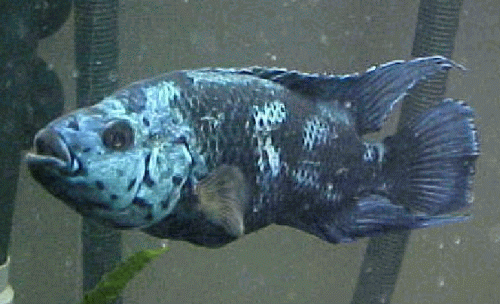Haha!
Dan, that's a WHOLE different thread! Tons of pages on the net if you look. Personally I'm a firm believer in the story that EBJDs are the result of a recessive mutation discovered in a spawn from two JDs in the tanks of Hector Luzardo in Argentina. I think they were discovered in 1985. I also think there's been a lot of selective breeding since then (I've attached a photo of what I guess is one of the early EBJDs) - hence the longer fins and variation in the amount of blue and copper in more recent specimens.
Here's the first piece on it:
http://www.elacuarista.com/secciones/tfhblue.htm
I found an excellent thread by an American breeder a while back who counted the percentages of blue versus normal in sussessive spawns from a male EBJD mated to his blue gene carrying (but normal looking) daughter. He found that the percentages corresponded to what you'd expect from Mendelian genetics (Google it if you're lost!).
To explain in a simplified manner...
Let's say a normal JD has two dominant alleles 'BB' and an EBJD has two recessive alleles 'bb'
Then if you mate EBJD to normal JD you expect the following according to Mendelian inheritance:
BB x bb ----> Bb, Bb, Bb, Bb
i.e. 100% offspring will have the alleles 'Bb'
All these offspring look like normal JDs but carry the recessive 'b' gene for electric blue colouration.
So if you now breed the EBJD (bb) parent to one of its offspring (Bb) then you expect the following:
bb x Bb ----> Bb, Bb, bb, bb
i.e. 50% offspring are normal-looking carriers of the electric blue gene (Bb) and 50% offspring are electric blue
At this stage the commercial breeders cull all the Bb offspring, leaving them with just electric blues to sell at crazy prices.
Anyway, the guy counted his fry and worked out that he did have around 50% blues versus normal-looking blue gene carriers in his spawns. He had initially thought there were fewer blues, but that was because the normals were out-competing the blues for food and so the blues were dying off. So he separated them from each other early and solved his problem.
The same thread also talks about a paper that was written recently where they compared the genotype (DNA) or normal and electric blue JDs and found that they were identical.
Unfortunately I forgot bookmark the site. Grrr. But it pretty much answered all my questions about how these fish turned up.
Ok, science lecture over!
--------------> MOVING ON!
Beautiful fish MacFish! I'm going to bug you on this forum in the Summer to see how you get on with breeding her to a normal!
I guess mine have a couple of inches to grow yet.
Here're some responses to the posts here:
1) If people have so much trouble breeding and sexing these fish, how the hell do they know that most of them turn out to be males? I reckon it's another case of internet rumour mongering.
2) I think you might be right about the substrate effect on brightness of colouration. Mine look stunning over white sand.
3) To the person who asked: My EBJDs are in a tank with 5 African Butterfly cichlids (A. thomasi) (who won't stop breeding!) and a pearl gourami.







